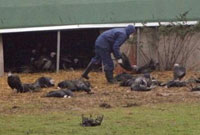Scientists search for source of H5N1 bird flu in Britain

Scientists were looking for the source of an outbreak of H5N1 bird flu – a disease that has killed scores of people around the world – in a poultry farm in eastern England on Wednesday.
Meanwhile, the process of culling about 5,000 turkeys, 1,000 ducks and 500 geese on the stricken farm continued.
Gas was being used to quickly kill the birds and their carcasses were being taken away in leak-proof trucks, said a spokesperson for the Department of Environment, Food and Rural Affairs, or Defra.
"We're in the process of trying to find out what the source of this outbreak was," the Defra spokesperson said on condition of anonymity, in keeping with department regulations.
"It could have come in through wild birds, wheels on vehicles or from people. We're not ruling anything out. All routes are being investigated."
Bird flu's return to Britain - weeks before the Christmas holidays - is a yet another blow to Britain's farmers, already struggling after livestock herds were hit this year by foot-and-mouth and bluetongue.
The unidentified source of the outbreak was closely related to the strains found in the Czech Republic and Germany earlier this year, acting Chief Veterinary Officer Fred Landeg said.
If the bird flu spreads, it could devastate the hugely profitable Christmas trade in poultry.
There was no indication that H5N1 had spread to other farms in the area - or that it had infected any humans in the area.
However, three separate control zones remained in effect.
A 3-kilometer (2-mile) protection zone banned the movement of all poultry and poultry products around the infected farm in Redgrave in Suffolk county, about 130 kilometers (80 miles) northeast of London.
A 10-kilometer (6-mile) surveillance zone authorized the search of all farms for any sign of the disease.
In the third zone, involving all of Suffolk and most of the neighboring Norfolk county, farmers were isolating their free-range birds from wild ones and barred from selling turkeys, ducks and geese outside that area.
The alarm was raised Sunday after a rise in death rates among birds owned by poultry producer Gressingham Foods, based in Woodbridge, Suffolk.
Landeg said Britain had successfully contained an outbreak of H5N1 earlier this year in Suffolk that led to the slaughter of 160,000 turkeys.
Bird flu has killed or prompted the slaughter of millions of birds worldwide since late 2003, when it began ravaging Asian poultry stocks. It has killed at least 206 people worldwide since 2003.
Experts believe most victims were probably infected through direct contact with sick birds.
Bird flu is difficult for humans to catch, but experts fear it could mutate into a form that spreads easily among people, potentially sparking a flu pandemic.
On Wednesday, workers doing the culling were given preventative doses of the anti-viral Tamiflu medication, believed to be effective against bird flu, and wore protective gear of gowns, gloves, boots and masks.
In Europe, H5N1 previously was found in France, Switzerland, Germany and elsewhere. Human cases have been recorded in Turkey and Azerbaijan.
Britain's first case of H5N1 was in a swan in Scotland in 2006. Experts say it's not surprising more H5 have been detected in Britain, particularly since surveillance systems worldwide are now geared to spot the virus.
Subscribe to Pravda.Ru Telegram channel, Facebook, RSS!





